Overfeeding complications - Study guides, Class notes & Summaries
Looking for the best study guides, study notes and summaries about Overfeeding complications? On this page you'll find 76 study documents about Overfeeding complications.
Page 4 out of 76 results
Sort by
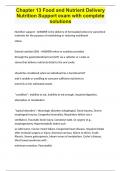
-
Chapter 13 Food and Nutrient Delivery Nutrition Support exam with complete solutions.
- Exam (elaborations) • 33 pages • 2024
-
- $8.99
- + learn more
Nutrition support - ANSWER-is the delivery of formulated enteral or parenteral nutrients for the purpose of maintaining or restoring nutritional status. Enteral nutrition (EN) - ANSWER-refers to nutrition provided through the gastrointestinal tract (GIT) via a catheter or a tube or stoma that delivers nutrients distal to the oral cavity should be considered when an individual has a functional GIT and is unable or unwilling to consume sufficient nutrients to meet his or her estimated n...
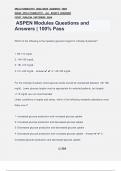
-
ASPEN Modules Questions and Answers | 100% Pass
- Exam (elaborations) • 354 pages • 2024
- Available in package deal
-
- $12.49
- + learn more
ASPEN Modules Questions and Answers | 100% Pass Which of the following is the inpatient glycemic target for critically ill patients? 1: 80-110 mg/dL 2: 140-180 mg/dL 3: 181-210 mg/dL 4: 211-240 mg/dL - Answer-2: 140-180 mg/dL For the critically ill patient, blood glucose levels should be maintained between 140-180 mg/dL. Lower glucose targets may be appropriate for selected patients, but targets <110 mg/dL are not recommended Under conditions of sepsis and stress, which of the follo...
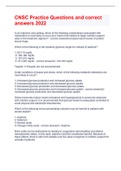
-
CNSC Practice Questions and correct answers 2022
- Exam (elaborations) • 72 pages • 2022
-
- $15.49
- + learn more
CNSC Practice Questions and correct answers 2022In an intensive care setting, which of the following complications associated with malnutrition is most likely to occur as a result of the failure to begin nutrition support early in the treatment regimen? Increased serum levels of protein-bound drugs Which of the following is the inpatient glycemic target for critically ill patients? 1: 80-110 mg/dL 2: 140-180 mg/dL 3: 181-210 mg/dL 4: 211-240 mg/dL 2: 140-180 mg/dL Targets <1...
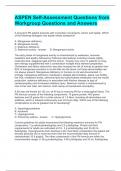
-
ASPEN Self-Assessment Questions from Workgroup Questions and Answers
- Exam (elaborations) • 77 pages • 2024
-
- $12.49
- + learn more
ASPEN Self-Assessment Questions from Workgroup Questions and Answers A long term PN patient presents with involuntary movements, tremor and rigidity. Which of the following etiologies may explain these symptoms? A. Manganese deficiency B. Manganese toxicity C. Selenium deficiency D. Selenium toxicity B. Manganese toxicity The early phase of manganese toxicity is characterized by weakness, anorexia, headache and apathy followed by Parkinson-like features including muscle rigidity, mask...
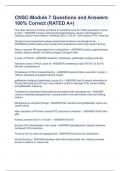
-
CNSC-Module 7 Questions and Answers 100% Correct (RATED A+)
- Exam (elaborations) • 4 pages • 2023
-
- $8.99
- + learn more
How does aluminum toxicity contribute to metabolic bone dz? What population is more at risk? - ANSWER-Causes osteoporosis/malacia/penia, causes osteomalacia by impairing calcium bone fixation, inhibiting 25D to 1-25 D**, and reduces PTH*; renal pts Omega 6 polyunsaturated soybean based lipid emulsions are thought to be.... - ANSWER-proinflammatory and contain toxic phytosterols which may impair bile flow Ways to prevent PN associated liver complications - ANSWER-cycling, supplementing ente...
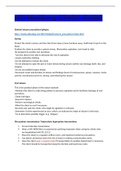
-
ATI MedSurg STUDY GUIDE
- Exam (elaborations) • 59 pages • 2022
-
- $9.99
- + learn more
ATI MedSurg STUDY GUIDE (Safety) Seizure precautions Epilepsy During Protect the client’s privacy and the client from injury (move furniture away, hold head in lap if on the floor). Position the client to provide a patent airway. (Remember aspiration, turn head to side) Be prepared to suction oral secretions. Turn the client to the side to decrease the risk of aspiration. Loosen restrictive clothing. Do not attempt to restrain the client. Do not attempt to open the jaw or insert air...
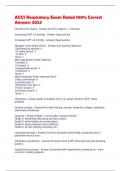
-
ACCS Respiratory Exam Rated 100% Correct Answers 2024
- Exam (elaborations) • 60 pages • 2024
-
- $16.49
- + learn more
ACCS Respiratory Exam Rated 100% Correct Answers 2024 Normal Urine Output - Answer 40 mL/hr (approx. 1 Liter/day) Decreased CVP (<2 mmHg) - Answer Hypovolemia Increased CVP (>6 mmHg) - Answer Hypervolemia Glasgow Coma Scale (GCS) - Answer Eye-opening response Spontaneous opening- 4 To verbal stimuli- 3 To pain- 2 None- 1 Most appropriate verbal response Oriented- 5 Confused- 4 Inappropriate words- 3 Incoherent- 2 None- 1 Most intergrated motor response (arm) Obeys commands...
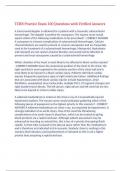
-
TCRN Practice Exam 100 Questions with Verified Answers,100% CORRECT
- Exam (elaborations) • 29 pages • 2024
-
- $11.49
- + learn more
TCRN Practice Exam 100 Questions with Verified Answers A transcranial doppler is obtained for a patient with a traumatic subarachnoid hemorrhage. The doppler is positive for vasospasm. The trauma nurse would expect which of the following medications to be prescribed? - CORRECT ANSWER A vasospasm is a known complication of subarachnoid hemorrhages. Calcium channel blockers are used to prevent or reverse vasospasms and are frequently used in the treatment of a subarachnoid hemorrhage. Metoprolo...

-
Home Nutrition Support with complete solutions
- Exam (elaborations) • 16 pages • 2022
-
- $9.99
- + learn more
When preparing a patient for home enteral nutrition therapy, initial written discharge information should include all of the following EXCEPT: 1: Type and location of feeding tube. 2: Name of formula and daily volume. 3: Volume, frequency of administration, times for tube flushes. 4: Daily protein content of the formula. - ANSWER 4 Detailed information and recommendations provided to home care agencies allow for continuation of patient education in the home, set monitoring and troubleshoo...
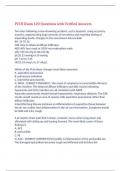
-
PCCN Exam 120 Questions with Verified Answers,100% CORRECT
- Exam (elaborations) • 40 pages • 2024
-
- $11.49
- + learn more
PCCN Exam 120 Questions with Verified Answers Two days following a near-drowning accident, a pt is dyspneic, using accessory muscles, expectorating large amounts of secretions and reporting feeling of impending death. Changes to the assessment data include RR- 24 TO 36 CXR clear to bilateral diffuse infiltrates ABG 40% face mask or 100% non-rebreather mask pO2 120 mm Hg to 56 mm Hg pCO2 33 mmHg to 56 mmHg pH 7.42 to 7.35 HCO3 24 meq/L to 27 mEq/L Which of the ff do these changes mos...

$6.50 for your textbook summary multiplied by 100 fellow students... Do the math: that's a lot of money! Don't be a thief of your own wallet and start uploading yours now. Discover all about earning on Stuvia


